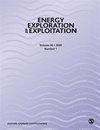利用 CHRCT 对厚硬顶薄煤层自成巷道进行动压控制的数值研究
IF 1.6
4区 工程技术
Q4 ENERGY & FUELS
引用次数: 0
摘要
近孔顶板切割技术(CHRCT,又称 "密集钻孔")因其经济和安全效益而被广泛应用于煤矿。不恰当的切削参数和支护方案会导致厚硬顶板自成巷道出现动压扰动。此外,在现场使用 CHRCT 对自成巷道的程序和过程进行全面描述非常困难,导致结果难以令人信服。因此,本研究旨在填补理论知识和方法上的空白。首先,研究了使用 CHRCT 自成巷道的动压特性,并对巷道的动压类型进行了分类。主要有三种类型:沿煤壁侧截顶、严重变形、第二工作面开采后巷道悬顶。此外,还研究了不同钻孔参数(倾角、深度和间距)对切顶形成巷道的影响。通过一系列实验,确定了 15°、8 米和 200 毫米的最佳钻孔倾角、深度和间距。然后,从应力演变、螺栓和缆索轴向力、顶板位移和结构等方面对嵌入巷道的三种支撑方案进行了比较。最后,本研究提出了一种动态压力缓解策略,即通过优化闭孔顶板切削参数和支护方案,监测和控制巷道地压,并采取辅助措施缓解压力。结果表明,该策略可有效消除巷道动压,满足全开采周期的稳定性要求。本文提出了一种通过数值模拟分析 CHRCT 的方法。此外,该方法对于在顶板厚且硬的薄煤层中使用 CHRCT 自成巷道的动压控制具有重要的理论和实践意义。本文章由计算机程序翻译,如有差异,请以英文原文为准。
Numerical study on the dynamic pressure control for self-forming roadways using CHRCT in thin coal seams with thick and hard roofs
Close-hole roof-cutting technology (CHRCT, also called “dense drilling”) has been widely applied in coal mines due to its economic and safety benefits. Inappropriate cutting parameters and support schemes can lead to dynamic pressure disturbances in self-forming roadways with thick and hard roofs. Moreover, fully characterizing the procedure and process of self-forming roadways using CHRCT in the field is difficult, resulting in unconvincing results. Therefore, this study aims to fill the gaps in theoretical knowledge and methodology. First, the dynamic pressure characteristics of the self-forming roadway using CHRCT were investigated, and the dynamic pressure types of the roadway were classified. There are three main types: roof cut off along the coal wall side of, severe deformation, and overhanging roof of a roadway after the second working face mining. The effects of different hole parameters (inclination angle, depth and spacing) on the roof cutting to form a roadway were also investigated. The optimal hole inclination, depth and spacing of 15°, 8 m, and 200 mm were determined through a series of experiments. Then, three support schemes embedded in the roadway were compared in terms of stress evolution, bolt and cable axial forces, roof displacement, and structure. Finally, this study proposes a dynamic pressure mitigation strategy through the optimization of parameters for close-hole roof-cutting and support schemes, monitoring and controlling ground pressure in roadways, and taking auxiliary measures for pressure relief. The results show that this strategy can effectively eliminate the dynamic pressure of the roadway and meet the stability requirements of the full mining cycle. This paper presents a methodology for analysing CHRCT via numerical simulation. Moreover, this approach is of great theoretical and practical importance for dynamic pressure control for self-forming roadways using CHRCT in thin coal seams with thick and hard roofs.
求助全文
通过发布文献求助,成功后即可免费获取论文全文。
去求助
来源期刊

Energy Exploration & Exploitation
工程技术-能源与燃料
CiteScore
5.40
自引率
3.70%
发文量
78
审稿时长
3.9 months
期刊介绍:
Energy Exploration & Exploitation is a peer-reviewed, open access journal that provides up-to-date, informative reviews and original articles on important issues in the exploration, exploitation, use and economics of the world’s energy resources.
 求助内容:
求助内容: 应助结果提醒方式:
应助结果提醒方式:


